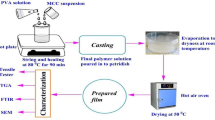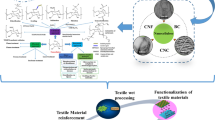Abstract
The objectives of this study were to produce nanofibrillated cellulose (NFC) from soybean hull (SH) by reactive extrusion and by bleaching with peracetic acid in combination with reactive extrusion, with both processes followed by an ultrasonication step, and to characterize the obtained materials according to chemical composition, morphology, crystallinity and thermal stability. Raw SH presented 32.91% cellulose, 3.05% hemicellulose and 2.05% lignin. The NFC sample prepared by reactive extrusion (ESH3-NFC sample) was submitted to three sequential extrusion steps. The first step involved extrusion with NaOH (10% w/w) and was followed by two sequential extrusion steps with H2SO4 (2% w/w); at the end of these processes, the product presented 78.20% cellulose, 1.50% hemicellulose and 1.49% lignin. The sample prepared by bleaching with peracetic acid followed by one extrusion step with H2SO4 (BESH-NFC sample) presented 92.03% cellulose, 0.56% hemicellulose and 1.32% lignin. Both processes of reactive extrusion and bleaching with peracetic acid combined with reactive extrusion were effective for obtaining NFC from SH, resulting in nanofibers with diameters of 80–100 nm, relative crystallinity indexes of 62 and 73%, and yields of 50 and 60%, respectively, as well as a higher thermal stability than that of SH. The proposed processes presented advantages, such as simplicity, reduced amounts of generated effluents and decreased time and number of washes employed during the obtainment of NFC when compared to several conventional processes based on combinations of chemical and mechanical treatments.
Graphic abstract






Similar content being viewed by others
References
AACC – American Association of Cereal Chemists (1990) Approved methods of the American Association of Cereal Chemists. AACC, St. Paul
Abdul Khalil HPS, Davoudpour Y, Islam MN, Mustaphaa A, Sudeshd K, Dungani R, Jawaid M (2014) Production and modification of nanofibrillated cellulose using various mechanical processes: a review. Carbohydr Polym 99:649–665
Alemdar A, Sain M (2008) Isolation and characterization of nanofibers from agricultural residues—wheat straw and soy hulls. Bioresour Technol 99:1664–1671
AOAC – Official Methods of Analysis (2003) 14th ed. Ass. Off. Analytical. Chem. Washington, USA, 2003
Arevalo-Gallegos A, Ahmad Z, Asgher M, Parra-Saldivar R, Iqbal HMN (2017) Lignocellulose: a sustainable material to produce value-added products with a zero waste approach—a review. Int J Biol Macromol 99:308–318
Baati R, Magnin A, Boufi S (2017) High solid content production of nanofibrillar cellulose via continuous extrusion. ACS Sustain Chem Eng 5:2350–2359
Berglund L, Noël M, Aitomäki Y, Öman T, Oskman K (2016) Production potential of cellulose nanofibers from industrial residues: efficiency and nanofibers characteristics. Ind Crop Prod 92:84–92
Boufi S, Chaker A (2016) Easy production of cellulose nanofibrils from corn stalk by a conventional high speed blender. Ind Crop Prod 93:39–47
Carvalho DM, Mosera C, Lindströma ME, Sevastyanova O (2019) Impact of the chemical composition of cellulosic materials on the nanofibrillation process and nanopaper properties. Ind Crop Prod 127:203–211
Chaker A, Mutjé P, Vilar MR, Boufi S (2014) Agriculture crop residues as a source for the production of nanofibrillated cellulose with low energy demand. Cellulose 21:4247–4259
Chen W, Yu H, Liu Y, Hai Y, Zhang M, Chen P (2011) Isolation and characterization of cellulose nanofibers from four plant cellulose fibers using a chemical-ultrasonic process. Cellulose 18:433–442
Conab—Nacional Supply Company (2018) Harvesting 2017/2018 of Brazil. IOP PublishingPhysicsWeb.http://www.conab.gov.br/OlalaCMS/uploads/arquivos/18_03_13_14_15_33_grao_marco_2018.pdf. Accessed 3 April 2018
Debiagi F, Faria-Tischer PCS, Mali S (2018) Cellulose and nanocellulose produced from lignocellulosic residues by reactive extrusion. In: Ayoub A, Lucia L (eds) Biomass extrusion and reaction technologies: principles to practices and future potential. American Chemical Society, Washington, DC, pp 227–248
Ferrer A, Salas C, Rojas OJ (2016) Physical, thermal, chemical and rheological characterization of cellulosic microfibrils and microparticles produced from soybean hulls. Ind Crops Prod 84:337–343
Flauzino-Neto WP, Mariano M, Silva ISV, Silvério HA, Putauxe JL, Otaguro H, Pasquini D, Dufresne A (2016) Mechanical properties of natural rubber nanocomposites reinforced with high aspect ratio cellulose nanocrystals isolated from soy hulls. Carbohydr Polym 153:143–152
Fung WY, Yuen KH, Liong MT (2010) Characterization of fibrous residues from agrowastes and the production of nanofibers. J Agric Food Chem 58:8077–8084
García A, Gandini A, Labidi J, Belgacem N, Bras J (2016) Industrial and crop wastes: a new source for nanocellulose biorefinery. Ind Crops Prod 93:26–38
Hassan SS, Williams GA, Jaiswal AK (2018) Emerging technologies for the pretreatment of lignocellulosic biomass. Bioresour Technol 262:310–318
Ho TTT, Abe K, Zimmermann T, Yano H (2015) Nanofibrillation of pulp fibers by twin-screw extrusion. Cellulose 22:421–433
Hussain Z, Sajjad W, Khan T, Wahid F (2019) Production of bacterial cellulose from industrial wastes: a review. Cellulose. https://doi.org/10.1007/s10570-019-02307-1
Ilyas RA, Sapuan SM, Ishak MR, Zainudin ES (2019) Sugar palm nanofibrillated cellulose [Arenga pinnata (Wurmb.) Merr]: effect of cycles on their yield, physic-chemical, morphological and thermal behavior. Int J Biol Macromol 123:379–388
Iwamoto S, Nakagaito AN, Yano H (2007) Nano-fibrillation of pulp fibers for the processing of transparent nanocomposites. Appl Phys A Mater Sci Process 89:461–466
Janoobi M, Oladi M, Davoudpour Y, Oskman K, Dufresne A, Hamzeh Y, Davoodi R (2015) Different preparation methods and properties of nanostructured cellulose from various natural resources and residues: a review. Cellulose 22:935–969
Jongaroontaprangsee S, Chiewchan N, Devahastin S (2018) Production of nanocellulose from lime residues using chemical-free technology. Mater Today Proc 5:11095–11100
Kargarzadeh H, Ioelovich M, Ahmad I, Thomas S, Dufresne A (2017) Methods for extraction of nanocellulose fromvarious sources. In: Kargarzadeh H, Ahmad I, Thomas S, Dufresne A (eds) Handbook of nanocellulose and cellulose nanocomposites, 1st edn. Wiley, New York, pp 1–49
Liang T, Wang L (2015) An environmentally safe and nondestructive process for bleaching birch veneer with peracetic acid. J Clean Prod 92:37–43
Lindström T (2017) Aspects on nanofibrillated cellulose (NFC) processing, rheology and NFC-film properties. Curr Opin Colloid Interface Sci 29:68–75
Meng F, Wang G, Du X, Wang Z, Xu S, Zhang Y (2019) Extraction and characterization of cellulose nanofibers and nanocrystals from liquefied banana pseudo-stem residue. Compos B 160:341–347
Merci A, Urbano A, Grossmann MVE, Tischer CA, Mali S (2015) Properties of microcrystalline cellulose extracted from soybean hulls by reactive extrusion. Food Res Int 73:38–43
Morán JI, Alvarez AV, Cyras VP, Vázquez A (2008) Extraction of cellulose and preparation of nanocellulose from sisal fibers. Cellulose 15:149–159
Naderi A, Koschella A, Heinze T, Shihc KC, Niehc MP, Pfeifer A, Change CC, Erlandsson J (2017) Sulfoethylated nanofibrillated cellulose: production and properties. Carbohydr Polym 169:515–523
Nuruddin M, Hosur M, Uddin MJ, Baah D, Jeelani S (2015) A novel approach for extracting cellulose nanofibers from lignocellulosic biomass by ball milling combined with chemical treatment. J Appl Polym Sci 133:42990
Paschoal GB, Muller CMO, Carvalho GM, Tischer CA, Mali S (2015) Isolation and characterization of nanofibrillated cellulose from oat hulls. Quím Nova 38:478–482
Qu X, Alvarez PJJ, Li Q (2013) Applications of nanotechnology in water and wastewater treatment. Water Res 47:3931–3946
Ramakrishnan A, Ravishankar K, Dhamodharan R (2019) Preparation of nanofibrillated cellulose and nanocrystalline cellulose from surgical cotton and cellulose pulp in hot-glycerol medium. Cellulose. https://doi.org/10.1007/s10570-019-02312-4
Ravindran L, Sreekala MS, Thomas S (2018) Novel processing parameters for the extraction of cellulose nanofibres (CNF) from environmentally benign pineapple leaf fibres (PALF): structure-property relationships. Int J Biol Macromol 131:858–870
Rojas MJ, Siqueira PF, Miranda LC, Tardioli PW, Giordano RLC (2014) Sequential proteolysis and cellulolytic hydrolysis of soybean hulls for oligopeptides and ethanol production. Ind Crops Prod 61:202–210
Rol F, Karakashov B, Nechyporchuk O, Terrien M, Meyer V, Dufresne A, Belgacem MN, Bras J (2017) Pilot-scale twin screw extrusion and chemical pretreatment as an energy-efficient method for the production of nanofibrillate cellulose at high solid content. ACS Sustain Chem Eng 5:6524–6531
Sango T, Yona AMC, Duchatel L, Marin A, Ndikontar MK, Joly N, LefebvreJ-M (2018) Step–wise multi–scale deconstruction of banana pseudo–stem (Musa acuminata) biomass and morpho–mechanical characterization of extracted long fibres for sustainable applications. Ind Crops Prod 122:657–668
Segal L, Creely JJ, Martin AE, Conrad CM (1959) An empirical method for estimating the degree of crystallinity of native cellulose using the X-ray diffractometer. Text Res J 29:786–794
Souza LO, Lessa OA, Dia MC, Tonoli GHD, Rezende VB, Martins MA, Neves ICO, Resende JV, Carvalho GEN, Vilas-Boas GVB, Oliveira JR, Franco M (2019) Carbohydr Polym 214:152–159
TAPPI TEST METHOD T222 om-88 (1999) Acid-insoluble lignin in wood and pulp. In: Tappi Test Methods. Tappi Press, Atlanta
Thambiraj S, Shankaran RD (2017) Preparation and physicochemical characterization of cellulose nanocrystals from industrial waste cotton. Appl Surf Sci 412:405–416
Tibolla H, Pelissari FM, Martins JT, Vicente AA, Menegalli FC (2018) Cellulose nanofibers produced from banana peel by chemical and mechanical treatments: characterization and cytotoxicity assessment. Food Hydroccoloid 75:192–201
Valdebenito F, Pereira M, Ciudad G, Briones R, Chinga-Carrasco G (2017) On the nanofibrillation of corn husks and oat hulls fibres. Ind Crops Prod 95:528–534
Van Soest PJ (1965) Symposium on factors influencing the voluntary intake of herbage by ruminants: voluntary intake in relation to chemical composition and digestibility. J Anim Sci 24:834–843
Wang B, Sain M, Oskman K (2007) Study of structural morphology of hemp fiber from the micro to the nanoscale. Appl Compos Mater 14:89–103
Zhao XB, Wang L, Liu DH (2008) Peracetic acid pretreatment of sugarcane bagasse for enzymatic hydrolysis: a continued work. J Chem Technol Biotechnol 83:950–956
Acknowledgments
The authors wish to thank the Laboratory of Microscopy and Microanalysis (LMEM) and the Laboratory of X-Ray Diffraction (LARX), State University of Londrina, for the analyses, Fundação Araucária - Brazil for providing financial support and CAPES-DS for the Flávia Debiagi grant.
Author information
Authors and Affiliations
Corresponding author
Ethics declarations
Conflict of interest
The authors declare that they have no conflict of interest.
Additional information
Publisher's Note
Springer Nature remains neutral with regard to jurisdictional claims in published maps and institutional affiliations.
Rights and permissions
About this article
Cite this article
Debiagi, F., Faria-Tischer, P.C.S. & Mali, S. Nanofibrillated cellulose obtained from soybean hull using simple and eco-friendly processes based on reactive extrusion. Cellulose 27, 1975–1988 (2020). https://doi.org/10.1007/s10570-019-02893-0
Received:
Accepted:
Published:
Issue Date:
DOI: https://doi.org/10.1007/s10570-019-02893-0




